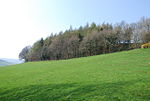Chilmark Quarries
All pages needing cleanupQuarries in WiltshireSites of Special Scientific Interest in WiltshireSites of Special Scientific Interest notified in 1977Special Areas of Conservation in England ... and 1 more
Wikipedia introduction cleanup from July 2020

Chilmark Quarries (grid reference ST974312) is a 9.65 hectare biological and geological Site of Special Scientific Interest (SSSI), in the ravine south of the village of Chilmark in Wiltshire, England. The SSSI was first notified in 1977. Its importance as a home for bats led to the site being designated in 2005 (together with Fonthill Grottoes) as a European Special Area of Conservation.The western section of the site is in Chilmark civil parish, while the eastern section (separated by a minor road) is in Teffont parish.
Excerpt from the Wikipedia article Chilmark Quarries (License: CC BY-SA 3.0, Authors, Images).Chilmark Quarries
Geographical coordinates (GPS) Address Nearby Places Show on map
Geographical coordinates (GPS)
| Latitude | Longitude |
|---|---|
| N 51.08 ° | E -2.0363888888889 ° |
Address
SP3 5BN , Chilmark
England, United Kingdom
Open on Google Maps









